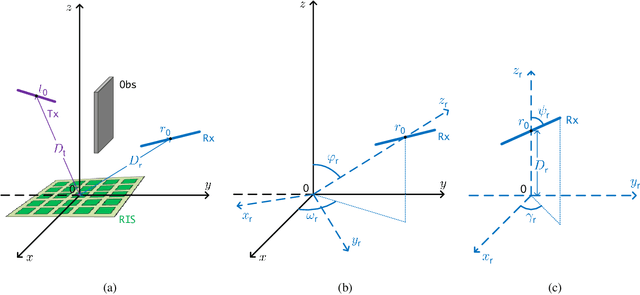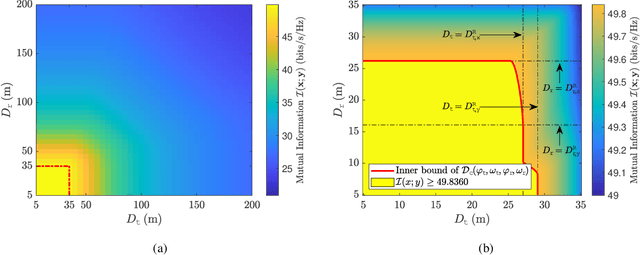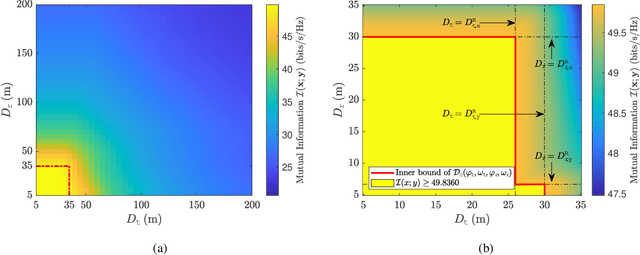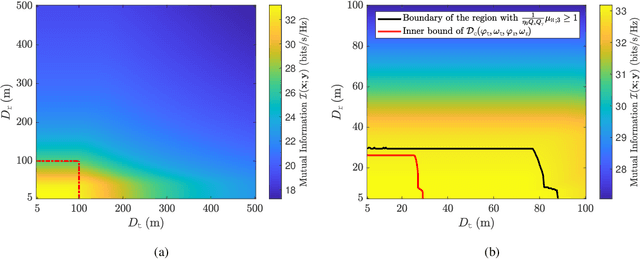Mingchen Zhang
Array Partitioning Based Near-Field Attitude and Location Estimation
Apr 23, 2025Abstract:This paper studies a passive source localization system, where a single base station (BS) is employed to estimate the positions and attitudes of multiple mobile stations (MSs). The BS and the MSs are equipped with uniform rectangular arrays, and the MSs are located in the near-field region of the BS array. To avoid the difficulty of tackling the problem directly based on the near-field signal model, we establish a subarray-wise far-field received signal model. In this model, the entire BS array is divided into multiple subarrays to ensure that each MS is in the far-field region of each BS subarray. By exploiting the angles of arrival (AoAs) of an MS antenna at different BS subarrays, we formulate the attitude and location estimation problem under the Bayesian inference framework. Based on the factor graph representation of the probabilistic problem model, a message passing algorithm named array partitioning based pose and location estimation (APPLE) is developed to solve this problem. An estimation-error lower bound is obtained as a performance benchmark of the proposed algorithm. Numerical results demonstrate that the proposed APPLE algorithm outperforms other baseline methods in the accuracy of position and attitude estimation.
Scalable Near-Field Localization Based on Array Partitioning and Angle-of-Arrival Fusion
Dec 19, 2023



Abstract:Existing near-field localization algorithms generally face a scalability issue when the number of antennas at the sensor array goes large. To address this issue, this paper studies a passive localization system, where an extremely large-scale antenna array (ELAA) is deployed at the base station (BS) to locate a user that transmits signals. The user is considered to be in the near-field (Fresnel) region of the BS array. We propose a novel algorithm, named array partitioning based location estimation (APLE), for scalable near-field localization. The APLE algorithm is developed based on the basic assumption that, by partitioning the ELAA into multiple subarrays, the user can be approximated as in the far-field region of each subarray. The APLE algorithm determines the user's location by exploiting the differences in the angles of arrival (AoAs) of the subarrays. Specifically, we establish a probability model of the received signal based on the geometric constraints of the user's location and the observed AoAs. Then, a message-passing algorithm, i.e., the proposed APLE algorithm, is designed for user localization. APLE exhibits linear computational complexity with the number of BS antennas, leading to a significant reduction in complexity compared to the existing methods. Besides, numerical results demonstrate that the proposed APLE algorithm outperforms the existing baselines in terms of localization accuracy.
OFDM-Based Massive Connectivity for LEO Satellite Internet of Things
Oct 31, 2022Abstract:Low earth orbit (LEO) satellite has been considered as a potential supplement for the terrestrial Internet of Things (IoT). In this paper, we consider grant-free non-orthogonal random access (GF-NORA) in orthogonal frequency division multiplexing (OFDM) system to increase access capacity and reduce access latency for LEO satellite-IoT. We focus on the joint device activity detection (DAD) and channel estimation (CE) problem at the satellite access point. The delay and the Doppler effect of the LEO satellite channel are assumed to be partially compensated. We propose an OFDM-symbol repetition technique to better distinguish the residual Doppler frequency shifts, and present a grid-based parametric probability model to characterize channel sparsity in the delay-Doppler-user domain, as well as to characterize the relationship between the channel states and the device activity. Based on that, we develop a robust Bayesian message passing algorithm named modified variance state propagation (MVSP) for joint DAD and CE. Moreover, to tackle the mismatch between the real channel and its on-grid representation, an expectation-maximization (EM) framework is proposed to learn the grid parameters. Simulation results demonstrate that our proposed algorithms significantly outperform the existing approaches in both activity detection probability and channel estimation accuracy.
Intelligent Reflecting Surface Aided MIMO with Cascaded Line-of-Sight Links: Channel Modelling and Capacity Analysis
Sep 18, 2021



Abstract:In this paper, we build up a new intelligent reflecting surface (IRS) aided multiple-input multiple-output (MIMO) channel model, named the cascaded LoS MIMO channel. The proposed channel model consists of a transmitter (Tx) and a receiver (Rx) both equipped with uniform linear arrays (ULAs), and an IRS used to enable communications between the transmitter and the receiver through the line-of-sight (LoS) links seen by the IRS. To model the reflection of electromagnetic waves at the IRS, we take into account the curvature of the wavefront on different reflecting elements (REs), which is distinct from most existing works that take the plane-wave assumption. Based on the established model, we study the spatial multiplexing capability and input-output mutual information (MI) of the cascaded LoS MIMO system. We generalize the notion of Rayleigh distance originally coined for the single-hop MIMO channel to the full multiplexing region (FMR) for the cascaded LoS MIMO channel, where the FMR is, roughly speaking, the union of Tx-IRS and IRS-Rx distance pairs that enable full multiplexing communication between the Tx and the Rx. We propose a new passive beamforming (PB) strategy named reflective focusing, which aims to coherently superimpose the waves originating from a transmit antenna, reflected by the IRS, and focused on a receive antenna. With reflective focusing, we derive an inner bound of the FMR, and provide the corresponding orientation settings of the antenna arrays that enable full multiplexing. We further employ the MI to measure the quality of the cascaded LoS MIMO channel, and formulate an optimization problem to maximize the MI over PB and antenna array orientations. We give analytical solutions to the problem under asymptotic conditions such as high or low signal-to-noise ratio (SNR) regimes. For general cases, we propose an alternating optimization method to solve the problem.
 Add to Chrome
Add to Chrome Add to Firefox
Add to Firefox Add to Edge
Add to Edge